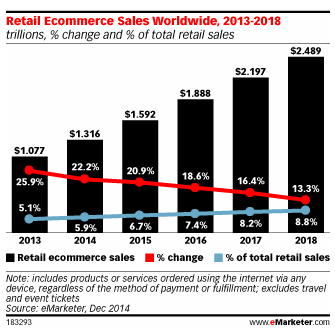Global Retail: Which Countries Prefer to Shop Online and How Retailers Are Encouraging Sales

According to a study of global retail by eMarketer, retail sales worldwide – including both in-store and internet purchases reached approximately $22.492 trillion in 2014. It is estimated by 2018, worldwide retail sales will increase 5.5 percent to reach $28.300 trillion.
Of that total, retail products and services purchased online accounted for 5.9 percent of the total retail market globally, estimated at $1.316 trillion.
 By 2018, that share is estimated to increase significantly to 8.8 percent.
By 2018, that share is estimated to increase significantly to 8.8 percent.
While we know without a doubt consumers across the globe are buying online – the statistics show that only a sliver of these online purchases make up the total retail sales generated in the US.
It is estimated, China and the US together made up 55 percent of global internet retail sales in 2014.
The study predicts China’s growth over the next five years will widen the gap between the two leading countries and the Chinese market will exceed $1 trillion in retail ecommerce sales by 2018.
This will account for more than 40 percent of the total worldwide.
Marketplace giants like Amazon will help maintain the US as a second runner up in the ecommerce market – with an estimated $500 billion by 2018.
In a distant third, the UK is estimated for about one-quarter of that figure.
 Although 63 percent of the US population is estimated to make a digital purchase this year, the metrics show the majority of US consumer purchases are still made in stores. While most US consumers are participating in online retail, only $1 out of every $5 are being spent online.
Although 63 percent of the US population is estimated to make a digital purchase this year, the metrics show the majority of US consumer purchases are still made in stores. While most US consumers are participating in online retail, only $1 out of every $5 are being spent online.
While only 27.5 percent (estimated) of China’s population purchased at least once in 2014, more than 10 percent of all retail purchases were bought on the internet.
Despite being the third-largest player in the ecommerce market, 73 percent of UK’s population made a purchase by the end of 2014. This (estimate) accounts for 13 percent of the total sales in the UK – leading all other countries including the US and China.
Judging by these statistics, what we can assume is shoppers in China and the UK prefer to shop online more than US consumers.
A recent Global Ecommerce Report by informational company, Nielsen suggests consumers are concerned about shipping costs and delivery time.
 According to the study, even though 63 percent of North American consumers research and read reviews and 78 percent find online shopping convenient, they remain hesitant to click the buy button.
According to the study, even though 63 percent of North American consumers research and read reviews and 78 percent find online shopping convenient, they remain hesitant to click the buy button.
Additional notes reveal only 21 percent of Americans surveyed would buy sporting goods online, compared with 42 percent of Asia-Pacific consumers.
In comparison to China, shipping costs in the US are expensive and according to the survey almost half of Americans said they don’t want to buy online because of that expense alone.
Shipping in the United Kingdom can be as low as one-third the cost of shipping in the United States. Additionally, research shows shipping companies in the US face more difficulty delivering to rural areas, which could be one of the main forces surging costs.
Amazon and Google are attempting to squash delivery concerns with a variety of services including Google Express, drone delivery and AmazonFresh.
Just last week, Amazon announced the launch of its one-hour delivery service, Prime Now, in select zip codes in Baltimore. The one-hour service is available to Amazon Prime subscribers through the Prime Now mobile app and costs $7.99. Their two-hour delivery is now free.
“Same day delivery will be the new normal in e-commerce in the not too distant future,” Pat Petriello, Sr. Marketplace Strategist at CPC Strategy said.
“Amazon’s massive investment in their fulfillment infrastructure has been leading up to offering same or next day delivery for all of their customers. This, to me, is an example of how even if you decide not to participate by selling on Amazon, your e-commerce store is affected by Amazon’s ability to redefine the entire ecosystem.”

In addition to Prime Now, Amazon will now begin testing Prime Air Delivery drones, thanks to an “experimental airworthiness certificate” from the Federal Aviation Administration approved on March 19.
The certificate will allow the company to test its unmanned aircraft with some restrictions. Amazon will only be able fly its test drones up to 400 feet above ground, in daylight, in clear conditions, monitored by a pilot and an observer.
Amazon will have to act swiftly though, as their main competitor Alibaba is already testing drones to deliver tea in China.
While US shoppers remain hesitant to abandon their brick-and-mortar roots, Nielsen data reveals online ordering is gaining momentum for a variety of non-tangible items such as airline reservations and concert tickets.
If Google and Amazon are able to streamline the fulfillment process, US consumers may be willing to warm up to the idea of online ordering tangible items much like China and consumers in Europe.
